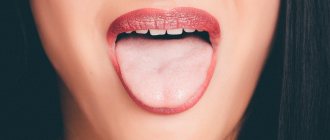Author of this article:
Lashkina Tatyana Gennadievna
Therapist, highest category
With good metabolism and proper hygiene, teeth are naturally white. Not dazzling, with a slight yellowish tint, but natural.
Unfortunately, not everyone is able to maintain white color. Fast meals rich in fats and carbohydrates, frequent consumption of tea and coffee, changes in the acid-base balance of saliva - all this contributes to more intense plaque formation, which gradually thickens. And sometimes a change in the color of the enamel is caused by taking certain medications.
The problem is solved with teeth whitening. This procedure is aimed at removing plaque from the enamel and eliminating coloring pigment. It is carried out in different ways.
Why do teeth become sensitive after whitening?
In the first days after the procedure, the enamel will be more sensitive; minor pain and reaction to temperature stimuli may occur. This is a completely normal phenomenon, since the teeth were exposed to aggressive external influences. However, there should not be acute pain - this situation indicates that the doctor chose the wrong dosage of the active substance.
Even the safest and gentlest whitening methods still have a negative effect on the enamel, destroying its mineral composition. Therefore, it is necessary to introduce healthy foods into the diet (see the list below), as well as use various preparations that will strengthen your teeth - in pharmacies you can purchase special pastes or compositions that are applied to the teeth for a few minutes.
Why do smokers get toothache?
The destructive effect on tooth enamel leads to toothache from smoking . The mechanism of pain is associated with several factors:
- increased overall sensitivity due to thinning of the enamel;
- inflammation of the gums due to the penetration of bacteria;
- development of pulpitis (inflammation affecting the root).
Increased sensitivity leads to the fact that a person feels pain when eating foods that are too cold or hot, sweet, sour, or overly spicy foods. Gradually, the situation worsens, then any impact on the damaged enamel begins to cause pain.
What diet should you follow after teeth whitening?
After bleaching, the enamel becomes more porous, and therefore there are certain restrictions in terms of nutrition and hygiene procedures. Therefore, after the lightening procedure, adhere to the “white diet”: exclude foods and drinks that contain coloring pigments and can lead to a change in the shade of the enamel. It is worth minimizing the amount of coffee, black tea, dark vegetables and fruits consumed.
To strengthen the enamel, introduce into your diet foods that contain large amounts of calcium and fluoride: milk, kefir, cottage cheese, fish, cheeses, eggs.
It is worth excluding factors that provoke unpleasant sensations, namely, too hard food, excessively hot and cold drinks. Follow the recommendation for an average of a week or longer, if necessary. It is also better to exclude sour and spicy foods from the diet: citrus fruits, sauces, ketchup, curry and other seasonings can increase tooth sensitivity.
How does smoking affect your gums?
The effect of smoking on teeth includes pathological processes in the soft tissues of the oral cavity. Tobacco smoke causes narrowing of small vessels - capillaries in the gums. Because of this, they become pale and are poorly supplied with oxygen and nutrients. An inflammatory process gradually develops, which may be accompanied by:
- bleeding;
- itching;
- purulent discharge;
- bad breath;
- pain and redness of the gums;
- swelling of soft tissues.
The condition progresses, causing teeth to become loose, even if they are not affected by caries.
Hygienic care rules
- Do not use a toothbrush with hard bristles - it will only increase the sensitivity that occurs immediately after the whitening procedure. It is better to give preference to a brush of medium hardness, since one that is too soft will not cope with removing plaque,
- Toothpaste should be free of abrasive substances that can damage the enamel. The best option is a paste to reduce hypersensitivity. It should be used for the first 2-3 weeks after whitening. Afterwards, it can be replaced with a paste that contains fluoride - this will be an excellent option for strengthening enamel and protecting against caries,
- After eating food (especially “coloring”), you should pay special attention to hygiene - use dental floss or a irrigator after each meal. And not only in the first days after whitening, but also in the subsequent ones - this recommendation should become a useful habit,
- Mouth rinses should not contain chlorhexidine, as it causes permanent staining of tooth enamel.
Even after whitening, you need to visit the dentist 1-2 times a year (but not earlier than six months later). Professional hygiene and removal of dental plaque will preserve the results and will be an excellent prevention of caries.
Women should avoid using lip gloss and bright lipstick for the first few days after whitening.
How does tobacco affect teeth?
When inhaled, tobacco smoke enters the oral cavity and spreads over its entire area, affecting both the teeth and the mucous membrane. That is why smoking causes complex harm, and complications in the future can extend far beyond the oral cavity. For a better understanding, we need to talk about each negative factor separately. Let's start with the teeth.
- Plaque and hard deposits. Many people wonder why smokers' teeth turn yellow. When smoking tobacco, tars and combustion products settle on the enamel, causing the characteristic smoker's plaque to form on the teeth. The higher your tobacco consumption, the more difficult it is to remove such plaque. As you know, over time, soft plaque hardens, tartar forms, and teeth acquire a characteristic yellow-brown tint. This means that the dyes have penetrated deep into the enamel and dentin.
- Smoking and tooth decay. Smoking is one of the factors that provokes the development of caries. There are several reasons for this. Firstly, tobacco smoke provokes the formation of microcracks on the surface of the enamel, which reduces its protective functions. Secondly, when smoking, the process of salivation is disrupted and dry mouth appears. As you know, saliva contains mucins that prevent the formation of a bacterial film. Add to these factors poor hygiene - and caries cannot be avoided.
Should I use home whitening products?
It is advisable to use homemade compositions to preserve the whitening results for a long time. But these should not be folk remedies, but professional ones, selected by your dentist. It is necessary to start using such compositions no earlier than 3 months after the professional procedure. It is better if the same system is used that was used in the clinic - for example, ZOOM or Amazing White - these brands provide formulations for use at home. But for this you will need to make individual mouth guards in which the active gel will be placed.
Whitening at home is especially effective for maintaining results after a professional procedure.
Plaque on teeth from smoking. How to remove?
Almost all smokers develop dark plaque on their teeth, which spoils their smile. You can't get rid of it with a toothbrush. It is necessary to carry out professional whitening, provided there are no contraindications. The clinic uses several techniques:
- Removing tartar and cleaning the surface from plaque using ultrasound.
- Gentle laser whitening that does not affect the enamel.
- Using a special gel that, under the influence of ultraviolet light, breaks down plaque.
Since whitening a smoker’s teeth is not an easy procedure that requires high qualifications and extensive experience, be careful when choosing a clinic.
Smoking after tooth extraction
Modern dentistry offers effective and painless methods of tooth extraction. Patients do not experience any discomfort during the procedure, but they are still worried and cannot resist smoking a cigarette after the treatment is completed.
However, dentists believe that smoking and dental health are incompatible things.
Cigarettes after removing affected teeth, especially if we are talking about wisdom teeth, can cause complications. In addition, tobacco smoke has an irritating effect on the wound surface, causing pain and aggravating inflammation. Smokers are advised to abstain from the habit at least in the first day after removal, and better yet, until complete healing.
What can you eat after whitening?
There are enough permitted products to not feel strict restrictions and not worry about anything. In addition, the white diet is not only a developed program that is good for teeth, but also an excellent opportunity to improve your body’s health and get rid of a few extra pounds.
Available food products:
- fermented milk products with a small percentage of fat content;
- rice;
- fish;
- eggs;
- cabbage;
- potato;
- oatmeal;
- cucumbers;
- apples;
- bananas;
- lean white meats: rabbit, chicken, turkey;
- pasta;
- bread;
- white beans.
How long does the white diet last?
The white, also known as transparent diet, lasts exactly two weeks. After time has passed, it is not recommended to immediately switch to your previous usual diet, as you risk harming the digestive system. Do it gradually . To begin with, increase your intake of wheat (white) bread and add fatty dairy products to your diet. After this, you can switch to fatty broths, stewed vegetables, salads with the addition of oil and vegetables prohibited in the diet.
Additional ways to prolong the effect
You can increase the effect in several ways. The basis for each of them is the same - proper cleaning.
- Brushing your teeth with a special paste selected by your dentist. The paste should reduce sensitivity and completely block pain; a cooling effect is possible. It is recommended to alternate this paste with others where fluoride and calcium predominate. It is important to know that the brush should be soft so as not to damage the enamel.
- Rinse aids. To quickly strengthen and maintain a light color, use a rinse containing fluoride.
- An excellent way is also to wear mouth guards with a special gel.
Smoking after dental implantation
Dental implantation is one of the most common prosthetic methods, which allows you to achieve an ideal aesthetic and functional result. There are many reasons why you should give up a bad habit during the procedure and recovery:
- slowing down the rate of healing of wound surfaces after implant installation;
- slower engraftment of the implant in the bone tissue, as well as an increased risk of rejection;
- increased risk of infection and development of pain syndrome;
- negative impact on the appearance and functional properties of the crown after installation.
Smoking harms not only natural teeth, but also artificial crowns, gradually affecting their color. A bad habit causes the structure to serve less than it should. You have to change crowns more often, which are not cheap.
Why is the diet called “white”?
The word “white” directly reflects the essence of the diet: only those foods that are not capable of staining teeth are allowed to be eaten. In dental practice, such a diet is also called colorless. In addition, the diet includes only healthy foods rich in calcium and other minerals that strengthen the enamel. Another advantage is that the calorie content of the menu is slightly reduced, which also allows you to slightly adjust your weight. The diet is based on natural protein and dairy products.
What is included in the “white” diet?
Actually, any products that are neutral in relation to the enamel, do not stain it and (importantly!) do not contain high acidity, which can also damage and soften the enamel. After brushing your teeth you can eat:
- White chicken meat;
- White fish;
- Porridge (oatmeal, millet, corn, buckwheat, rice);
- Cheese (curd, tofu, unleavened varieties);
- Nuts;
- Vegetables (white and Chinese cabbage, white beans) and fruits (bananas, peeled apples);
- White mushrooms;
- Rice and pasta made from durum wheat.
How to maintain the effect of teeth whitening
Despite all the benefits of the white diet, it will not be possible to maintain the achieved results only with its help. Dentists also advise patients:
- Don't forget to use dental floss and a special mouthwash after meals.
- Properly brush your teeth twice a day for at least 3-5 minutes.
- Use high-quality toothbrushes and toothpastes.
Following all these simple recommendations will allow your teeth to remain snow-white for a long time. And you - to delight others with a dazzling Hollywood smile.
sign up for a consultation
Are there any disadvantages?
Of course, a colorless diet has its downsides. For example, some find it very difficult to give up certain foods, leading to early relapse. It should also be noted that the diet after teeth whitening is not suitable for everyone. Contraindications include individual intolerance to dairy or other products included in the diet list. Pregnant, lactating and elderly people should also not follow the diet. We recommend that you consult your doctor first if you have problems with your stomach and digestive system in general.











